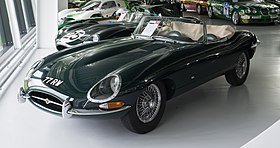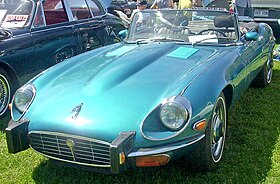Jaguar E-Type
| Jaguar E-Type | |
|---|---|

The first production open two-seater
a 1961 E-Type Series 1 3.8-Litre roadster |
|
| Overview | |
| Manufacturer | Jaguar Cars |
| Also called | Jaguar XK-E |
| Production | 1961–75 |
| Assembly | Coventry, England |
| Designer | Malcolm Sayer |
| Body and chassis | |
| Class | Sports car (S) |
| Layout | FR layout |
| Related |
Jaguar D-Type Jaguar XJ13 |
| Chronology | |
| Predecessor | Jaguar XK150 |
| Successor | Jaguar XJ-S |
| Series 1 | |
|---|---|
 |
|
| Overview | |
| Production | March 1961–68 |
| Body and chassis | |
| Body style | 2-door fastback coupe 2-door 2+2 fastback coupe 2-door roadster |
| Powertrain | |
| Engine | 3.8 L XK I6 4.2 L XK I6 |
| Transmission | 4-speed manual; 3-speed automatic (automatic available 1966-onward, 2+2 model only) |
| Dimensions | |
| Wheelbase | 96.0 in (2,438 mm) (FHC / OTS) 105.0 in (2,667 mm) (2+2) |
| Length | 175.3125 in (4,453 mm) (FHC / OTS) 184.4375 in (4,685 mm) (2+2) |
| Width | 65.25 in (1,657 mm) (all) |
| Height | 48.125 in (1,222 mm) (FHC) 50.125 in (1,273 mm) (2+2) 46.5 in (1,181 mm) (OTS) |
| Kerb weight | 2,900 lb (1,315 kg) (FHC) 2,770 lb (1,256 kg) (OTS) 3,090 lb (1,402 kg) (2+2) |
| Series 2 | |
|---|---|
 |
|
| Overview | |
| Production | 1968–71 |
| Body and chassis | |
| Body style | 2-door fastback coupe 2-door 2+2 fastback coupe 2-door roadster |
| Powertrain | |
| Engine | 4.2 L XK I6 |
| Dimensions | |
| Kerb weight | 3,018 lb (1,369 kg) (FHC) 2,750 lb (1,247 kg) (OTS) 3,090 lb (1,402 kg) (2+2) |
| Series 3 | |
|---|---|

Jaguar E-Type Series 3 roadster
|
|
| Overview | |
| Production | 1971–75 |
| Body and chassis | |
| Body style | 2-door 2+2 coupe 2-door roadster |
| Powertrain | |
| Engine | 5.3 L Jaguar V12 engine |
| Dimensions | |
| Wheelbase | 105 in (2,667 mm) (both) |
| Length | 184.4 in (4,684 mm) (2+2) 184.5 in (4,686 mm) (OTS) |
| Width | 66.0 in (1,676 mm) (2+2) 66.1 in (1,679 mm) (OTS) |
| Height | 48.9 in (1,242 mm) (2+2) 48.1 in (1,222 mm) (OTS) |
| Kerb weight | 3,361 lb (1,525 kg) (2+2) 3,380 lb (1,533 kg) (OTS) |
The Jaguar E-Type, or the Jaguar XK-E for the North American market, is a British sports car, which was manufactured by Jaguar Cars Ltd between 1961 and 1975. Its combination of beauty, high performance and competitive pricing established the model as an icon of the motoring world. At a time when most cars had drum brakes, live rear axles, and mediocre performance, the E-Type sprang on the scene with 150 mph and a sub-7 second 0–60 time, monocoque construction, disc brakes, rack and pinion steering, independent front and rear suspension, and unrivalled looks. The E-Type was based on Jaguar's D-Type racing car which had won the 24 Hours of Le Mans three consecutive years (1955–1957) and, as such, it employed the racing design of a body tub attached to a tubular framework, with the engine bolted directly to the framework.
On its release in March 1961Enzo Ferrari called it "the most beautiful car ever made". In 2004, Sports Car International magazine placed the E-Type at number one on their list of Top Sports Cars of the 1960s. In March 2008, the Jaguar E-Type ranked first in The Daily Telegraph online list of the world's "100 most beautiful cars" of all time. In popular culture the car features in the Austin Powers film series which parodies the Swinging London fashion scene of the 1960s.
The E-Type was initially designed and shown to the public as a rear-wheel drive grand tourer in two-seater coupé form (FHC or Fixed Head Coupé) and as a two-seater convertible (OTS or Open Two Seater). A "2+2" four-seater version of the coupé, with a lengthened wheelbase, was released several years later.
Later model updates of the E-Type were officially designated "Series 2" and "Series 3", and over time the earlier cars have come to be referred to as "Series 1." As with other largely hand made cars of the time, changes were incremental and ongoing, which has led to confusion over exactly what is a Series 1 car. This is of more than academic interest, as Series 1 E-Types—and particularly Series 1 OTS (convertible) examples—have values far in excess of Series 2 and 3 models.
Some transitional examples exist. For example, while Jaguar itself never recognised a "Series 1½" or "Series 1.5," over time, this sub-category has been recognised by the Jaguar Owners Club of Great Britain and other leading authorities. The "pure" 4.2-litre Series 1 was made in model years 1965-1967 (earlier Series 1 models had a smaller, 3.8-litre engine with less torque). The 4.2-litre Series 1 has serial or VIN numbers 1E10001 - 1E15888 (in the case of the left hand drive OTS), and 1E30001 - 1E34249 (in the case of the left hand drive hardtop, or FHC). The Series 1.5 left hand drive OTS has serial numbers 1E15889 - 1E18368, with the hardtop version of the Series 1.5 having VIN numbers 1E34250 - 1E35815. Series 1.5 cars were made in model year 1968.
...
Wikipedia
